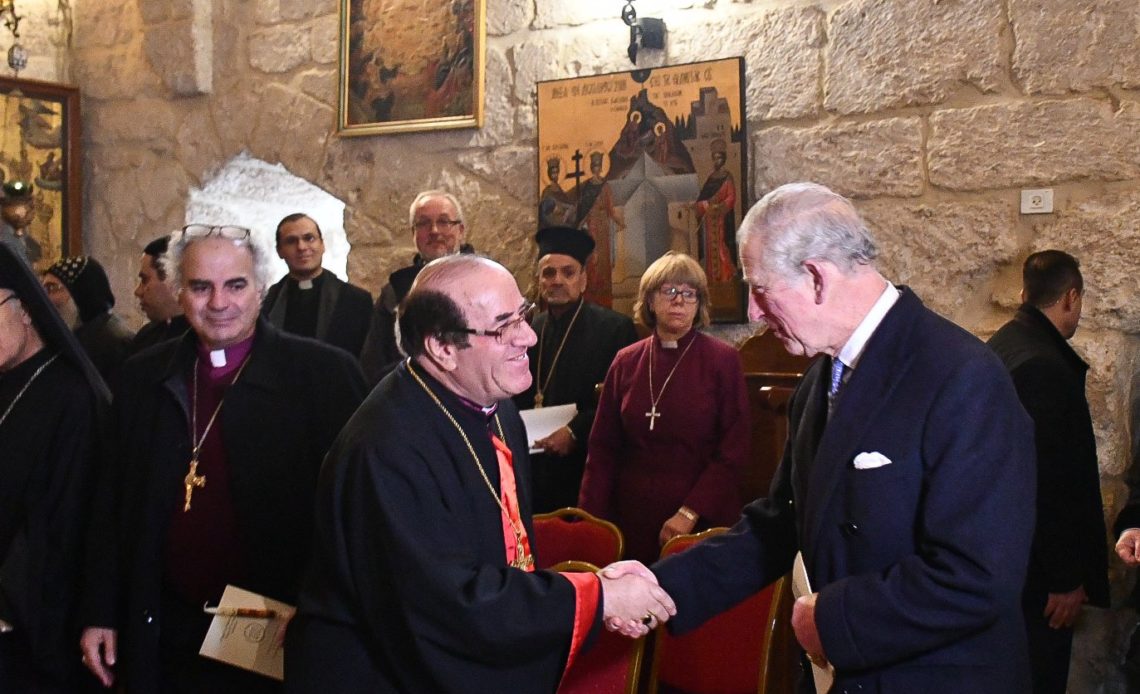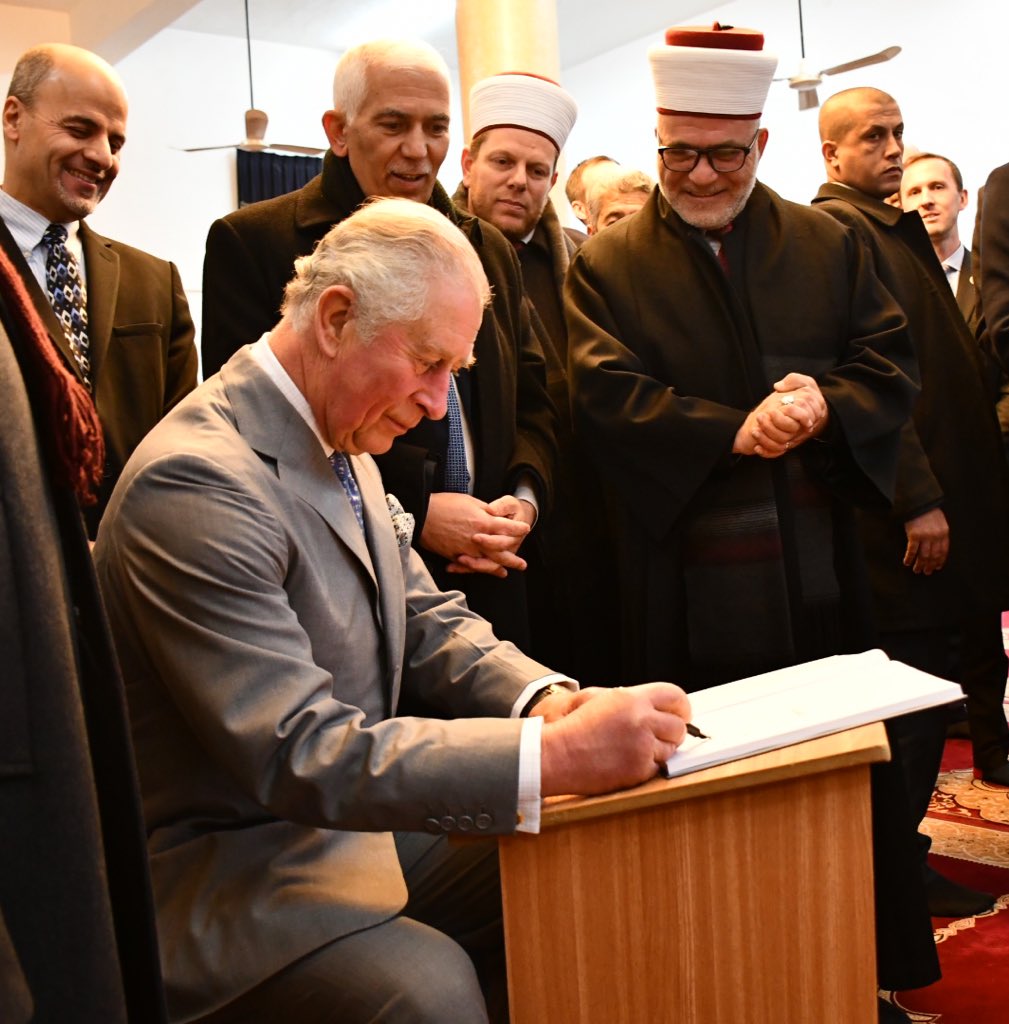
The Prince of Wales continued his official visit to the Occupied Palestine Territories on Friday, undertaking engagements in Bethlehem on his first visit to the country.
Prince Charles’s day began with a walk through Bethlehem with Muslim and Christian leaders before a visit to the Mosque of Omar, where he learned about its history and signed the visitors’ book – signing his name in both English and Arabic.

According to Clarence House, the Mosque of Omar was built to “commemorate the visit to Bethlehem of Omar Ibn Al-Khattab, the second Caliph (successor) to the Prophet Muhammed.” It is also the only mosque in Bethlehem.
Prince Charles then attended an Ecumenical Service at the Church of the Nativity and met with senior Greek, Franciscan and Armenian Orthodox clerics. He viewed the church to see Byzantine and Crusader-era mosaics before heading to the Greek Orthodox Chapel of Saint George for the service.
[getty src=”1195620902″ width=”594″ height=”396″]After the church service, Prince Charles attended a reception at the Casa Nova, a Franciscan pilgrim house built for visitors to the Church of the Nativity. At the reception, Prince Charles met with Palestinian Christians, people who work in health and education, and Palestinian refugees before delivering a speech.
[getty src=”1195641375″ width=”594″ height=”412″]Prince Charles told the guests, “I must say for most of my life – and as someone brought up on the biblical stories of the Holy Land, to be with you here, in Bethlehem, means more to me than you can ever know! Therefore, to receive President Abbas’s kind invitation to make what is my first official visit here was greatly appreciated.”
He continued, “It is, if I may say so, humbling and profoundly moving to have taken my place in the long line of pilgrims who have journeyed to this special place of such great significance.
“Bethlehem is a part of us all, and the Church of the Nativity is at the heart of Bethlehem. It was especially important to me to give thanks for Christian unity, which we see in the sharing of this sacred space and in the way the different Palestinian Christian communities, so deeply rooted in this land, continue to live side-by-side. You are the ‘living stones’ to which St. Peter first referred. And I need hardly say that it would be the greatest tragedy if those “living stones” were to disappear from the Holy Land after these past millennia.”
Speaking of the religious divide between people, he said:
“In the United Kingdom, I have long sought to celebrate the rich diversity of belief which we enjoy; and to ensure that people of all faiths, and none, understand how much their place in our society is valued. Elsewhere in the world, too, I have endeavoured to build bridges between different religions, so that we might learn from each other and be stronger together as a result.
“It breaks my heart, therefore, that we should continue to see so much suffering and division. No one arriving in Bethlehem today could miss the signs of continued hardship and the situation you face, and I can only join you, and all communities, in your prayers for a just and lasting peace. We must pursue this cause with faith and determination, striving to heal the wounds which have caused such pain. It is my dearest wish that the future will bring freedom, justice and equality to all Palestinians, enabling you to thrive and to prosper.”
Before leaving to meet with the iconographers who work at the Bethlehem Icon Centre, Prince Charles spoke about his desire to visit Bethlehem again, saying, “It is a great regret that my time here has been all too short and I pray that one day I shall be able to return, – Insha’Allah – and to make a fuller pilgrimage in the footsteps of our Lord. Until then, I can only thank you again, Ladies and Gentlemen, for the warmth of the welcome I have received here and to say how much all the people of the Holy Land will remain in my thoughts and special prayers.”
Prince Charles’s full speech can be found here.
Prince Charles then departed to meet with President Mahmoud Abbas at his official residence, where the two had a private meeting after inspecting an Honour Guard.
[getty src=”1195641587″ width=”594″ height=”395″]His final engagement in Bethlehem came as a tour of the olive trees and olive garden at the Carmelite Convent and Sacred Heart Fathers Monastery.
“Olive trees are a major agricultural crop in the Occupied Palestinian Territories, where they are mainly grown for olive oil production for domestic consumption,” per Clarence House.
“The olive tree is seen by many Palestinians as being a symbol of nationality and connection to the land, particularly due to their slow growth and longevity.”
Prince Charles spoke with convent gardeners to hear about how they cultivate their olives and was offered samples of various products made with the produce before planting a tree to commemorate his visit.
[getty src=”1195703961″ width=”594″ height=”396″]Back in Jerusalem, Prince Charles paid a visit to the Church of St. Mary Magdalene and viewed his grandmother, Princess Alice’s, tomb.

